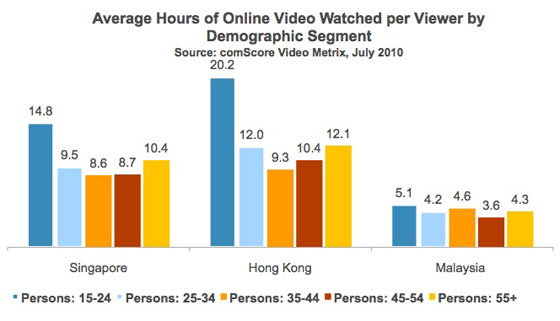By the Numbers: Online Video Consumption in Asia
Across much of Asia and the world, online video consumption has become nearly synonymous with Web usage. Of the six markets in the Asia-Pacific region currently reported in Comscore Video Metrix, nearly all see more than 80 percent of their online audiences watching online video.
Not only does online video reach a large number of visitors, but it is also one of the most engaging online activities. In Japan, viewers spend nearly 17 hours a month consuming video with double-digit hours also spent in Hong Kong (12.7 hours) and Singapore (10.4 hours). As high-speed broadband continues to gain adoption enhancing the user experience, it is expected that visitors will continue to consume more video content online.
Online Video Goes Mainstream
Online video used to be considered an activity largely for younger users, but as content options have continued to expand, online video viewing has become ubiquitous across demographic segments. A look across Singapore, Hong Kong, and Malaysia revealed that although there are higher engagement rates among some segments, online video viewing is no longer dominated by a single age group of users. Malaysia experienced the greatest disparity in demographic usage with viewers age 15-24 accounting for 39 percent of video viewers in July.
In terms of viewer engagement, viewers age 15-24 represented the most “tuned in” segment across the three markets. Hong Kong saw viewers in this segment consume more than 20 hours of online video during the month, with Singapore viewers 15-24 watching nearly 15 hours per month. Interestingly in each market, visitors age 55 and older represented another strong segment of engaged users.
Although each market has its unique demographic patterns, it’s important to note that online video viewing is a mainstream Web activity with a far reach and engaging quality.
Online Video and TV: What’s Next
There is no doubt that video will continue to play a strong role in the online consumer experience. In an arena that was once dominated by user generated content, online video is maturing considerably as a medium with more professionally produced content – including broadcast TV content – capturing consumers’ attention, and shifting the dynamics of “where, when, and how” people consume video content.
In Singapore, MediaCorp recently launched xinMSN with Microsoft and offers users the ability to catch up on the broadcast local shows that they have missed. Media Prima in Malaysia, the largest free-to-air TV stations, has offered “catch-up TV” since last year and just launched Tonton for video-on-demand over the Web. There are other similar plans in the region.
Where will these initiatives lead? A look at cross-platform TV viewing in the more matured U.S. showed that 35 percent of viewers are either cross-platform (Internet and traditional television) or online-TV viewers only as the dynamics of TV-viewing continue to change with a growing number of content options available online.
Broadly, audiences are increasingly enjoying the option of tuning in to their favorite scripted TV programs online because they value freedom and personal empowerment. This has both a time and a space component – in time, with on demand viewing on one’s own schedule, and in space, with the convenience of watching wherever you want, and on the screen that is most convenient to you.
What will be important for the industry is how to effectively monetise online video content, an area that is still in its infancy. Questions such as which types of video ads are most effective, the debate on the free versus paid model for content viewing, and the cross-platform synergies that exist will be important for the industry to address as the online video space continues to evolve.




